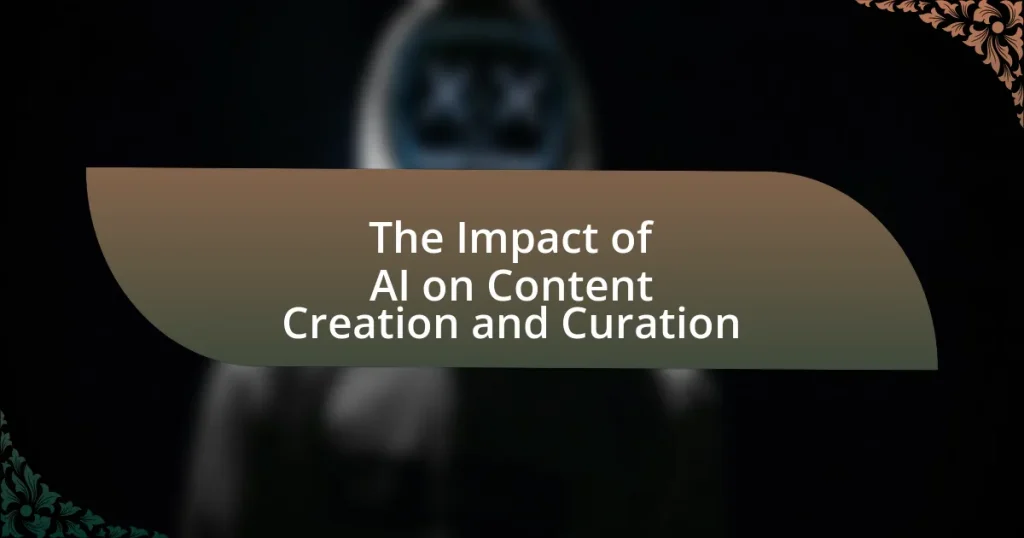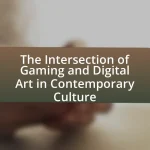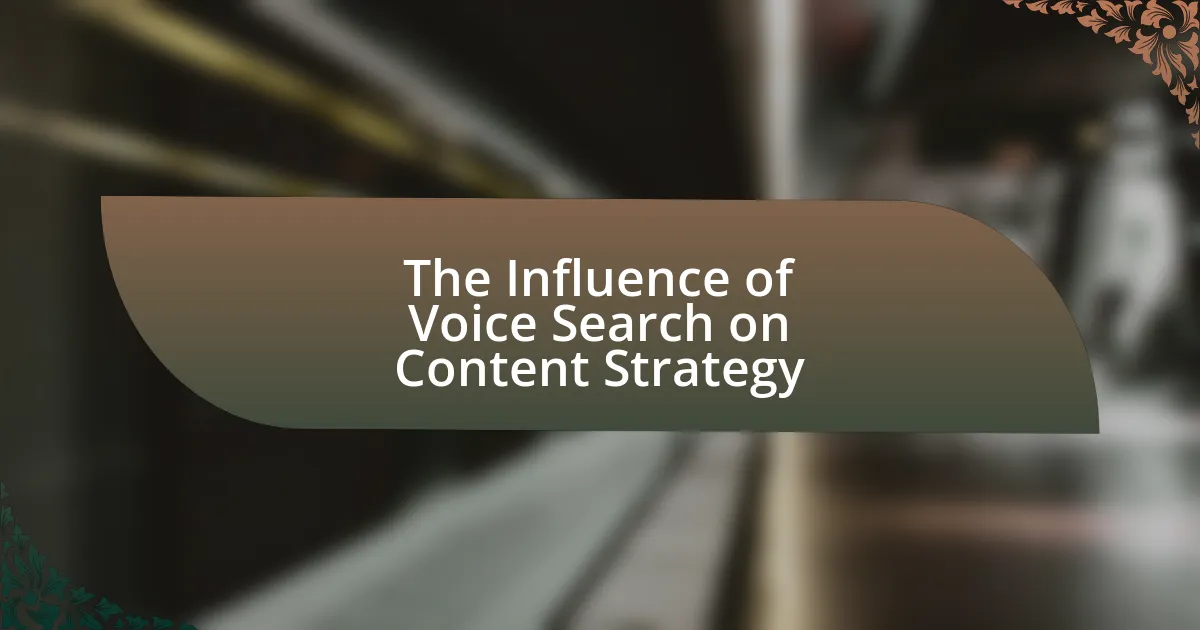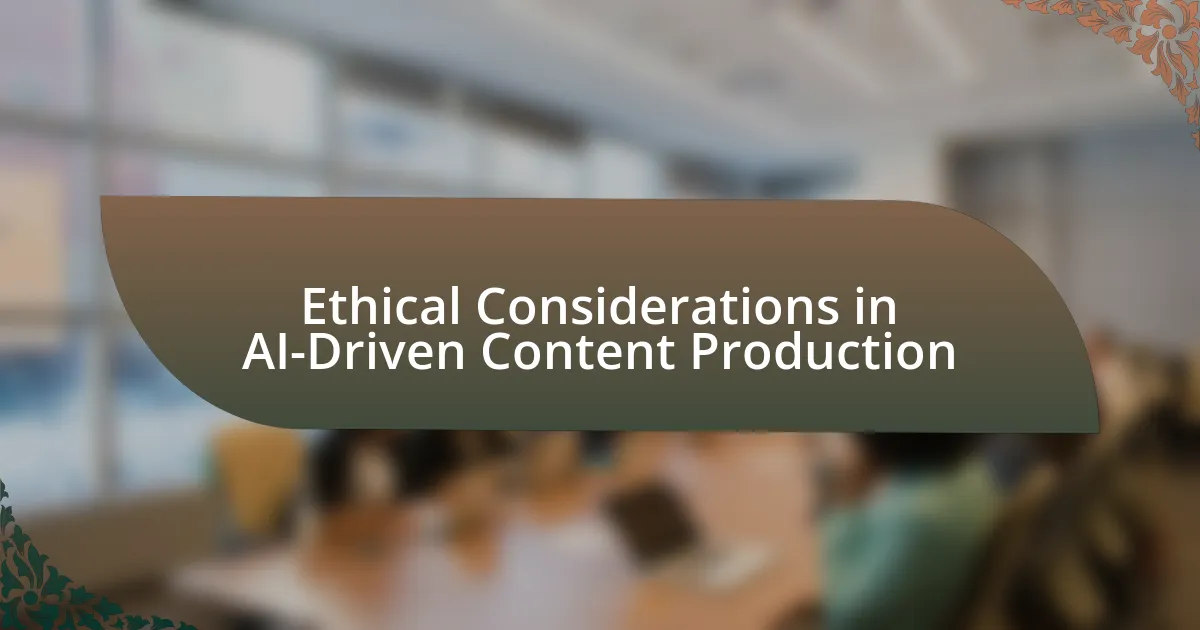The article examines the impact of artificial intelligence (AI) on content creation and curation, highlighting how AI enhances efficiency, personalization, and automation in these processes. It discusses the transformation of traditional content methods through technologies such as natural language processing and machine learning, which enable faster production and tailored recommendations. The article also addresses the ethical considerations surrounding AI, including bias and copyright issues, while exploring the challenges and limitations of current AI technologies. Additionally, it outlines future trends in AI-driven content strategies and offers practical tips for effectively integrating AI tools into content workflows.
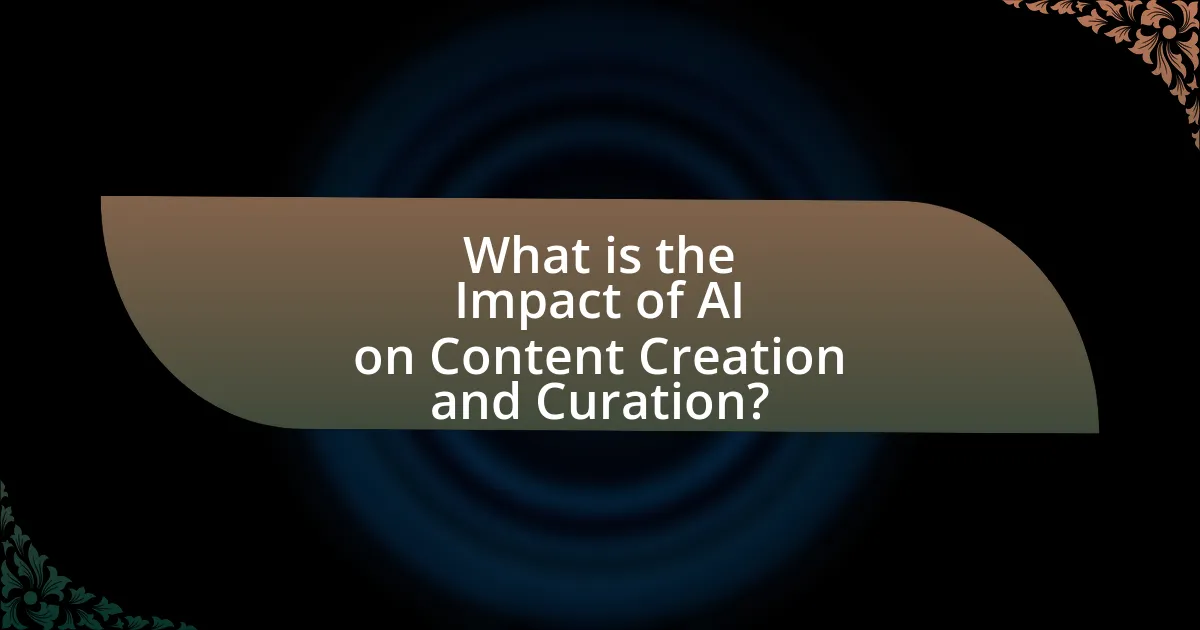
What is the Impact of AI on Content Creation and Curation?
AI significantly enhances content creation and curation by automating processes, improving personalization, and increasing efficiency. For instance, AI tools like natural language processing algorithms can generate articles, summarize content, and suggest topics based on trending data, which streamlines the content creation process. Additionally, AI-driven analytics can analyze user behavior to curate personalized content recommendations, leading to higher engagement rates. According to a report by McKinsey, organizations that leverage AI in content strategies can see productivity improvements of up to 40%. This demonstrates that AI not only optimizes the workflow but also enhances the relevance of content delivered to users.
How has AI transformed traditional content creation methods?
AI has transformed traditional content creation methods by automating processes, enhancing personalization, and improving efficiency. Automation tools powered by AI, such as natural language generation and image recognition, enable creators to produce content faster and with less manual effort. For instance, platforms like OpenAI’s GPT-3 can generate articles, blogs, and social media posts in a fraction of the time it would take a human writer. Additionally, AI algorithms analyze user data to tailor content to specific audience preferences, resulting in higher engagement rates. According to a report by McKinsey, companies that leverage AI in content creation can increase productivity by up to 40%. This shift not only streamlines workflows but also allows creators to focus on strategic and creative aspects of their work.
What technologies are driving AI in content creation?
Natural Language Processing (NLP), machine learning, and deep learning are the primary technologies driving AI in content creation. NLP enables machines to understand and generate human language, facilitating tasks such as text generation and sentiment analysis. Machine learning algorithms analyze vast datasets to identify patterns and improve content relevance, while deep learning models, particularly neural networks, enhance the quality of generated content by mimicking human-like writing styles. For instance, OpenAI’s GPT-3, a state-of-the-art language model, utilizes these technologies to produce coherent and contextually relevant text, demonstrating the effectiveness of AI in content creation.
How do AI tools enhance creativity in content creation?
AI tools enhance creativity in content creation by providing innovative suggestions, automating repetitive tasks, and analyzing audience preferences. These tools utilize machine learning algorithms to generate ideas, optimize content structure, and suggest relevant topics based on trending data. For instance, platforms like OpenAI’s GPT-3 can produce diverse content styles and formats, allowing creators to explore new narratives and perspectives. Additionally, AI-driven analytics can identify what resonates with audiences, enabling content creators to tailor their work for maximum engagement. This combination of idea generation and audience insight significantly boosts the creative process, making it more efficient and effective.
What role does AI play in content curation?
AI plays a crucial role in content curation by automating the process of discovering, organizing, and recommending relevant content to users. Through algorithms and machine learning, AI analyzes vast amounts of data to identify trends, preferences, and user behavior, enabling personalized content delivery. For instance, platforms like Spotify and Netflix utilize AI-driven recommendation systems that enhance user engagement by suggesting content based on individual viewing or listening habits. This capability not only improves user experience but also increases content visibility and consumption, as evidenced by a report from McKinsey, which states that AI can boost content engagement by up to 30%.
How does AI improve the efficiency of content curation?
AI improves the efficiency of content curation by automating the discovery, organization, and personalization of content. Through machine learning algorithms, AI can analyze vast amounts of data to identify relevant articles, videos, and other media that align with user preferences and trending topics. For instance, platforms like Feedly utilize AI to curate news feeds tailored to individual interests, significantly reducing the time users spend searching for content. Additionally, AI tools can categorize and tag content automatically, streamlining the curation process and ensuring that users receive timely and pertinent information. This automation not only enhances user experience but also allows content curators to focus on strategic decision-making rather than manual sorting.
What algorithms are commonly used in AI-driven content curation?
Common algorithms used in AI-driven content curation include collaborative filtering, content-based filtering, and natural language processing (NLP) techniques. Collaborative filtering analyzes user behavior and preferences to recommend content that similar users have liked, while content-based filtering focuses on the attributes of the content itself to suggest similar items. NLP techniques, such as sentiment analysis and topic modeling, help in understanding and categorizing content based on its textual information. These algorithms enhance user experience by personalizing content delivery, as evidenced by platforms like Netflix and Spotify, which utilize these methods to tailor recommendations based on user interactions and content characteristics.
What are the ethical considerations of using AI in content creation and curation?
The ethical considerations of using AI in content creation and curation include issues of bias, transparency, accountability, and intellectual property. Bias in AI algorithms can lead to the perpetuation of stereotypes or misinformation, as seen in studies where AI-generated content reflects the biases present in training data. Transparency is crucial, as users should be aware when content is AI-generated, which fosters trust and informed consumption. Accountability is another concern; determining who is responsible for harmful or misleading content produced by AI remains a complex issue. Lastly, intellectual property rights are challenged by AI’s ability to generate original content, raising questions about ownership and copyright. These considerations highlight the need for ethical guidelines and regulations in the deployment of AI technologies in content creation and curation.
How does AI impact copyright and intellectual property in content creation?
AI significantly impacts copyright and intellectual property in content creation by complicating ownership and originality issues. As AI systems generate content, determining the authorship becomes challenging, leading to potential disputes over who holds the copyright. For instance, the U.S. Copyright Office has stated that works created solely by AI without human intervention may not qualify for copyright protection, as copyright law traditionally requires human authorship. This shift raises questions about the legal status of AI-generated works and the rights of creators who use AI tools, as they may inadvertently infringe on existing copyrights if the AI is trained on copyrighted material.
What are the potential biases in AI-generated content?
Potential biases in AI-generated content include algorithmic bias, data bias, and representation bias. Algorithmic bias occurs when the algorithms used to generate content reflect the prejudices present in their training data, leading to skewed or unfair outputs. Data bias arises when the datasets used to train AI models are not representative of the broader population, resulting in content that may overlook or misrepresent certain groups. Representation bias happens when the AI fails to adequately represent diverse perspectives, often favoring dominant cultural narratives. Research by the AI Now Institute highlights that biased training data can perpetuate stereotypes and reinforce existing inequalities in media representation.
How does AI influence audience engagement with content?
AI significantly enhances audience engagement with content by personalizing user experiences and optimizing content delivery. Through algorithms that analyze user behavior and preferences, AI tailors recommendations, ensuring that content resonates with individual interests. For instance, platforms like Netflix and Spotify utilize AI-driven recommendation systems, which have been shown to increase user interaction and retention rates by up to 80%. Additionally, AI tools can analyze engagement metrics in real-time, allowing content creators to adjust strategies dynamically, further boosting audience interaction. This data-driven approach not only improves the relevance of content but also fosters a deeper connection between the audience and the material presented.
What metrics can be used to measure audience engagement with AI-generated content?
Metrics that can be used to measure audience engagement with AI-generated content include click-through rates (CTR), time spent on page, social media shares, comments, and conversion rates. Click-through rates indicate how many users interacted with the content compared to how many viewed it, providing insight into its appeal. Time spent on page reflects the depth of engagement, as longer durations suggest that the content is resonating with the audience. Social media shares and comments serve as qualitative measures of engagement, showing how much the audience values and interacts with the content. Conversion rates track the effectiveness of the content in prompting desired actions, such as signing up for a newsletter or making a purchase, thus demonstrating its impact on audience behavior.
How does personalization through AI affect user experience?
Personalization through AI significantly enhances user experience by tailoring content and recommendations to individual preferences and behaviors. This customization leads to increased engagement, as users are more likely to interact with content that resonates with their interests. For instance, a study by McKinsey & Company found that personalized experiences can lead to a 10-30% increase in conversion rates. Additionally, AI algorithms analyze user data to predict future preferences, ensuring that the content remains relevant over time. This dynamic adjustment fosters a sense of connection and satisfaction, ultimately improving overall user retention and loyalty.
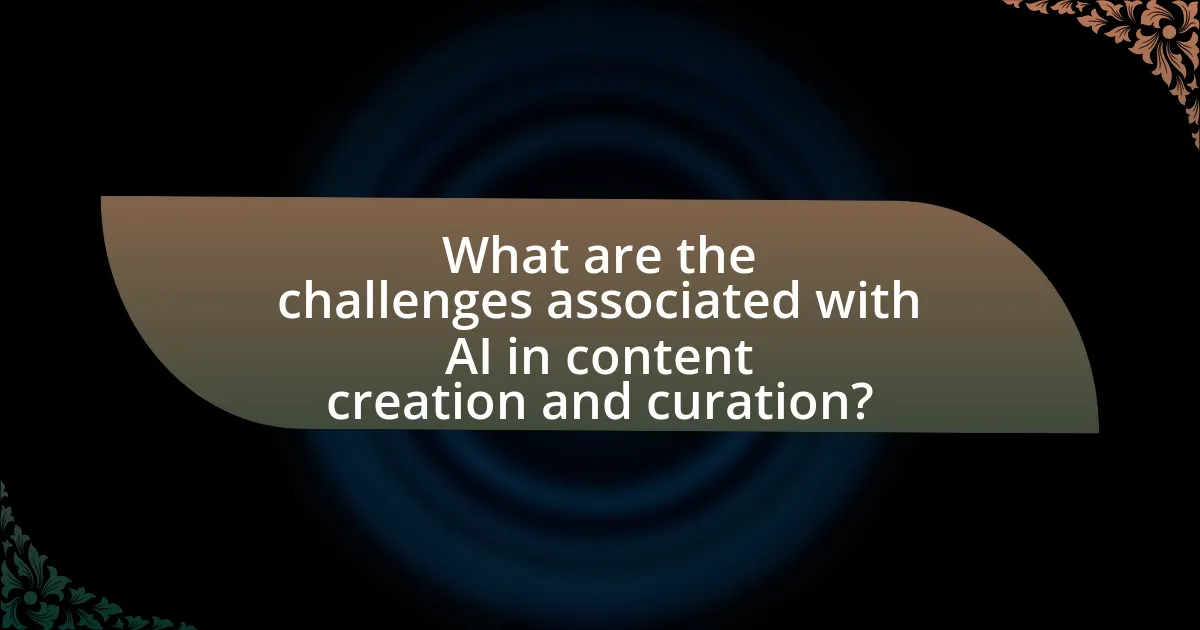
What are the challenges associated with AI in content creation and curation?
The challenges associated with AI in content creation and curation include issues of quality control, bias, and the need for human oversight. Quality control is a significant concern, as AI-generated content may lack the nuance and creativity that human creators provide, leading to generic or inaccurate outputs. Bias in AI algorithms can result in skewed perspectives or reinforce stereotypes, as these systems often learn from existing data that may reflect societal biases. Furthermore, the reliance on AI necessitates human oversight to ensure ethical standards and contextual relevance, which can complicate workflows and increase operational costs. According to a study by the Stanford University Center for Research on Foundation Models, AI systems can inadvertently perpetuate biases present in training data, highlighting the importance of careful curation and monitoring in AI applications.
What limitations do current AI technologies face in content creation?
Current AI technologies face limitations in content creation primarily due to their inability to fully understand context and nuance. These systems often struggle with generating content that requires deep emotional intelligence, cultural awareness, or complex reasoning, which are essential for high-quality, engaging material. For instance, AI-generated text can lack originality and may produce repetitive or generic content, as evidenced by studies showing that AI models often rely on patterns in training data rather than creative thought. Additionally, AI tools may inadvertently propagate biases present in their training datasets, leading to content that can be misleading or offensive.
How does the quality of AI-generated content compare to human-generated content?
AI-generated content often matches or exceeds the quality of human-generated content in specific contexts, particularly in terms of consistency and speed. Studies have shown that AI can produce text that is grammatically correct and contextually relevant, with some AI models achieving scores comparable to human writers in tasks like news article generation and technical writing. For instance, a 2020 study published in the journal “Nature” demonstrated that AI-generated articles were indistinguishable from human-written ones in blind tests conducted with readers. However, human-generated content typically excels in creativity, emotional depth, and nuanced understanding of complex topics, which AI still struggles to replicate.
What are the risks of over-reliance on AI in content creation?
Over-reliance on AI in content creation poses several risks, including diminished creativity, loss of authenticity, and potential misinformation. When creators depend heavily on AI tools, they may produce content that lacks unique perspectives and innovative ideas, as AI typically generates outputs based on existing data patterns rather than original thought. This reliance can lead to a homogenization of content, where diverse voices and styles are overshadowed by algorithmically driven narratives. Furthermore, AI systems can inadvertently propagate biases present in their training data, resulting in misleading or inaccurate information being disseminated. A study by the Pew Research Center highlights that 60% of experts believe AI could exacerbate misinformation issues, underscoring the importance of critical oversight in AI-generated content.
How can organizations address the challenges of AI in content creation?
Organizations can address the challenges of AI in content creation by implementing robust guidelines and training programs for their teams. These measures ensure that employees understand AI’s capabilities and limitations, fostering a collaborative environment where human creativity complements AI efficiency. For instance, a study by McKinsey found that organizations that invest in employee training related to AI technologies see a 20-30% increase in productivity. Additionally, establishing ethical frameworks for AI use in content generation can mitigate risks associated with misinformation and bias, as highlighted by the AI Ethics Guidelines from the European Commission. By prioritizing transparency and accountability, organizations can effectively navigate the complexities of AI in content creation.
What best practices should be followed when integrating AI into content strategies?
To effectively integrate AI into content strategies, organizations should prioritize data-driven decision-making, ensuring that AI tools are utilized to analyze audience behavior and preferences. This approach allows for the creation of personalized content that resonates with target demographics, enhancing engagement and conversion rates. For instance, a study by McKinsey & Company found that companies leveraging AI for personalization can achieve a 10-30% increase in revenue. Additionally, maintaining a human oversight in AI-generated content is crucial to ensure quality and relevance, as AI can sometimes produce inaccurate or contextually inappropriate material. Implementing iterative testing and feedback loops will further refine AI applications, allowing for continuous improvement in content effectiveness.
How can teams balance AI tools with human creativity?
Teams can balance AI tools with human creativity by integrating AI as a supportive resource while allowing human input to drive the creative process. This approach enables teams to leverage AI’s efficiency in data analysis and content generation, while human creativity ensures originality and emotional resonance. For instance, a study by McKinsey found that organizations that combine AI capabilities with human skills can enhance productivity by up to 20%. By using AI for repetitive tasks, teams can focus on brainstorming and refining ideas, ultimately fostering a collaborative environment where both AI and human creativity thrive.
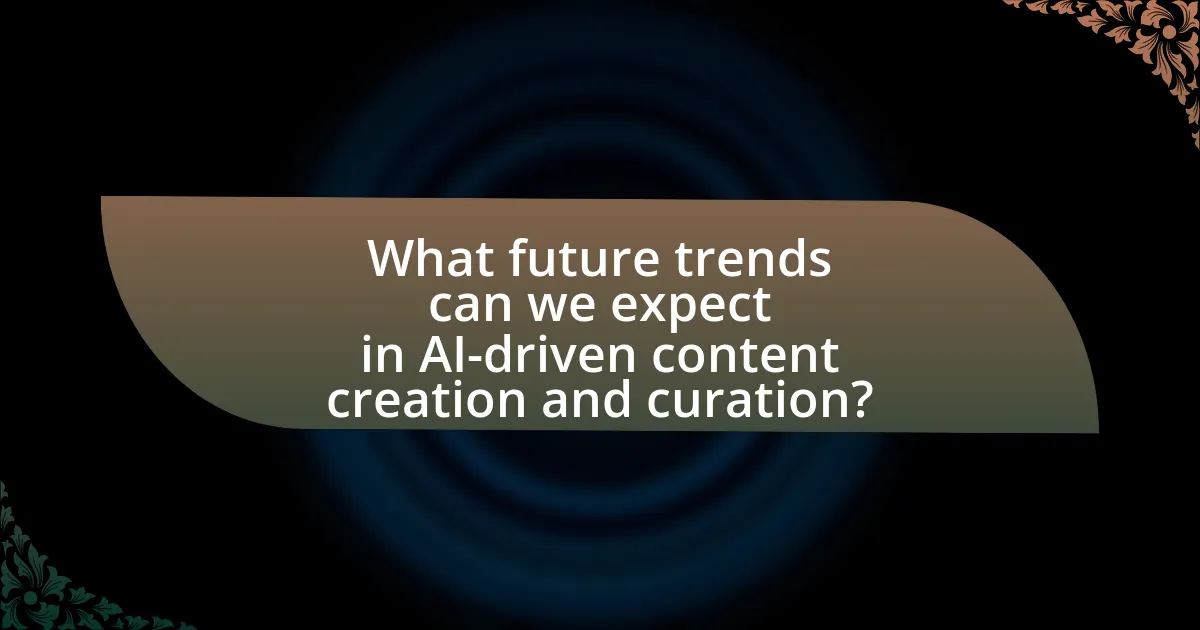
What future trends can we expect in AI-driven content creation and curation?
Future trends in AI-driven content creation and curation include increased personalization, enhanced automation, and improved collaboration between humans and AI. Personalization will leverage advanced algorithms to tailor content to individual user preferences, as evidenced by platforms like Netflix and Spotify, which already utilize AI to recommend content based on user behavior. Enhanced automation will streamline the content creation process, allowing for faster production and distribution, as seen in tools like OpenAI’s GPT-3, which can generate text and assist in writing tasks. Improved collaboration will involve AI acting as a co-creator, providing suggestions and insights that enhance human creativity, a trend supported by research indicating that AI can augment human capabilities rather than replace them.
How will advancements in AI technology shape content creation in the next decade?
Advancements in AI technology will significantly enhance content creation in the next decade by automating processes, personalizing experiences, and improving efficiency. AI tools will enable creators to generate high-quality content rapidly, utilizing natural language processing and machine learning algorithms to analyze audience preferences and trends. For instance, platforms like OpenAI’s GPT-3 have already demonstrated the ability to produce coherent and contextually relevant text, indicating that future iterations will likely offer even more sophisticated capabilities. Additionally, AI-driven analytics will provide insights into user engagement, allowing content creators to tailor their work to meet specific audience needs, thereby increasing relevance and impact.
What emerging AI tools are likely to influence content creation and curation?
Emerging AI tools likely to influence content creation and curation include generative AI models like OpenAI’s ChatGPT and DALL-E, as well as tools like Jasper and Copy.ai. These tools utilize advanced natural language processing and machine learning algorithms to generate text and images, enabling creators to produce high-quality content rapidly. For instance, ChatGPT can assist in drafting articles, while DALL-E can create unique visuals based on textual descriptions. Additionally, platforms like Canva are integrating AI features to streamline design processes, making it easier for users to curate visually appealing content. The rise of these tools is supported by the increasing demand for personalized and engaging content, as evidenced by a report from McKinsey, which highlights that companies leveraging AI in content strategies can see a 20% increase in engagement rates.
How might user expectations evolve with AI-generated content?
User expectations regarding AI-generated content are likely to evolve towards a demand for higher quality, personalization, and transparency. As AI technology advances, users will increasingly expect content that is not only accurate and relevant but also tailored to their individual preferences and needs. For instance, a study by McKinsey & Company indicates that 71% of consumers expect companies to deliver personalized interactions, which highlights the growing importance of customization in user experiences. Additionally, users will seek greater transparency about the AI processes behind content creation, desiring clarity on how data is used and how content is generated. This shift in expectations will drive content creators to enhance their AI systems to meet these demands effectively.
What practical tips can enhance the use of AI in content creation and curation?
To enhance the use of AI in content creation and curation, implement the following practical tips: first, utilize AI tools for data analysis to identify trending topics and audience preferences, which can guide content strategy. For instance, platforms like BuzzSumo analyze social media engagement to reveal popular content themes. Second, leverage AI-driven writing assistants, such as Grammarly or Jasper, to improve content quality and coherence, ensuring that the output is polished and engaging. Third, integrate AI for personalized content recommendations, as seen in platforms like Netflix, which uses algorithms to suggest content based on user behavior, thereby increasing user engagement. Lastly, employ AI for automated content curation, utilizing tools like Feedly to aggregate relevant articles and resources, streamlining the curation process and saving time. These strategies collectively enhance the effectiveness and efficiency of AI in content creation and curation.
How can content creators effectively collaborate with AI tools?
Content creators can effectively collaborate with AI tools by integrating AI-driven analytics and content generation into their workflows. This collaboration allows creators to leverage AI for data insights, enhancing audience targeting and engagement strategies. For instance, tools like Google Analytics provide real-time data on user behavior, enabling creators to tailor their content to meet audience preferences. Additionally, AI writing assistants, such as Grammarly or Jasper, can help streamline the writing process, ensuring clarity and improving overall quality. Research indicates that 70% of marketers believe AI will significantly impact their content strategies, highlighting the importance of this collaboration in optimizing content creation and curation.
What strategies can improve the quality of AI-generated content?
To improve the quality of AI-generated content, implementing a combination of fine-tuning models, incorporating human oversight, and utilizing diverse training datasets is essential. Fine-tuning models on specific domains enhances relevance and accuracy, as demonstrated by studies showing that domain-specific training can increase performance metrics by up to 30%. Human oversight ensures that the content aligns with contextual nuances and ethical standards, which is crucial given that AI lacks inherent understanding of cultural subtleties. Additionally, using diverse training datasets mitigates biases and improves the richness of the generated content, as evidenced by research indicating that varied data sources lead to more comprehensive and engaging outputs.
